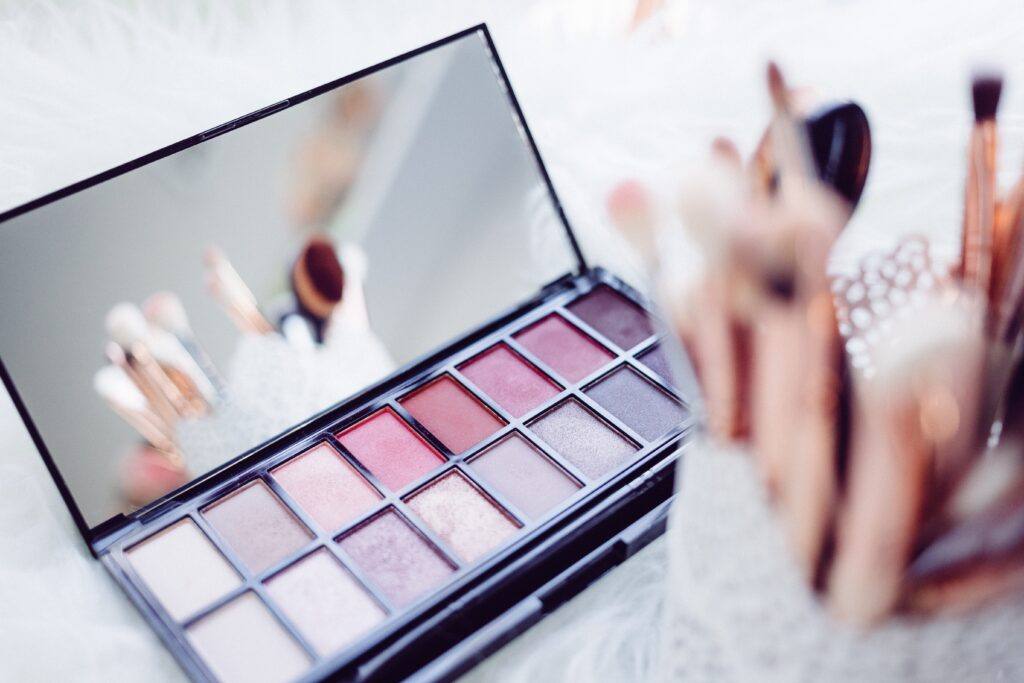
As moms we are constantly worrying about what we’re giving our kids and if their products are safe. However, it’s important to make sure that we’re taking care of ourselves and ensuring that our daily routines are free of chemicals.
Take this as a sign to learn about harmful chemicals found in makeup and then check your products for them. Keep yourself safe and healthy so that you can continue being the best mom ever!
Continue reading to learn about some ingredients to look for in your cosmetics and the harm that exposure can cause.
TALCUM POWDER
Talcum powder is commonly used in cosmetic products such as blush, contour palettes, face powder, eye shadow, and powder foundations. This natural mineral is harmless on its own but is mined near asbestos. Asbestos fibers may contaminate the talcum powder used in cosmetics, and there is no way to know unless the batch is tested.
Look for the following variations on your labels:
- Talcum powder
- Talc
- Talcum
- Cosmetic talc
- Magnesium silicate
Exposure to asbestos in makeup can result in a significant increase in developing cancer, such as peritoneal mesothelioma, a cancer that affects the lining of the stomach. Typically, the effects and symptoms of asbestos exposure will not occur until much later in life, so it’s important to take safety measures now.
To keep yourself safe, it’s best to try and avoid products that contain talc as not all talc is tested for asbestos. If you do decide to use a product with talc, do your best to avoid using it around the eyes, nose, or mouth as it’s easier to ingest or inhale.
Another concern about talcum powder is its link to ovarian cancer. Some studies have shown that women who use talcum powder in the genital area may be at an increased risk of developing ovarian cancer.
There are many talc-free cosmetics available on the market. Look for products that are labeled “talc-free” or “asbestos-free.”
As a recommendation-
It is important to be aware of the risks of talcum powder in order to fully understand the extent of those risks. You can stay informed about the latest research on talcum powder and litigation involving this current issue. The DrugWatch website, FDA website, and Campaign for Safe Cosmetics website are good resources for information about the risks of talcum powder and safe alternatives. It’s for our health.
FORMALDEHYDE
Formaldehyde is an organic compound gas and a known carcinogen that can wreak havoc on the body when its fumes are inhaled. In terms of cosmetics, formaldehyde is used to increase shelf life and decrease the chances of contamination.
Since formaldehyde is used as a gas in cosmetics, you won’t typically see it listed as such on a label. Instead of looking for formaldehyde on the label, look for:
- DMDM hydantoin
- Methylene glycol
- Quaternium 15
- 3 dioxane
- Formalin
These ingredients can commonly be found in skincare products, nail polish, and polish remover. The good thing is that risks from formaldehyde exposure, including cancer development, are pretty low unless the substance is inhaled.
However, some may still face reactions such as itchy skin, redness, or eye, nose, and throat irritation. Individuals may develop an allergic reaction to formaldehyde as well, even years after using the same product.
FRAGRANCE
Fragrance is used as an umbrella term in the cosmetics industry and doesn’t always mean what a consumer may assume. The broad use of fragrance as an ingredient could indicate that a much worse ingredient is included in the product.
The Food and Drug Administration does not require every ingredient in a fragrance to be listed out, which means that toxins such as dibutyl phthalate and diethylhexyl phthalate do not have to be explicitly disclosed on the packaging. This is harmful because both are phthalates that can reproductive harm and are potential carcinogens.
To steer clear of unknown exposure, try to refrain from using products that have fragrances listed as an ingredient. Fragrance-free items are a great alternative and help you know what is truly in your makeup and beauty products.
FINAL THOUGHTS
While these are not the only chemicals and ingredients to look out for, it’s a place to start. The best thing you can do is to educate yourself on the topic and make decisions that are best for you and your lifestyle. We are all learning about this together, so the more we talk about it and share our knowledge the better decisions we can make.
As consumers have started to call for more makeup product ingredient transparency, brands have begun to listen and make changes. There are now brands that are committed to clean beauty and only providing safe consumer products.
And remember, you don’t need to wear makeup if you don’t want to! You can feel confident without makeup if you choose.
Leave a Reply